The AMD Radeon R9 290X Review
by Ryan Smith on October 24, 2013 12:01 AM EST- Posted in
- GPUs
- AMD
- Radeon
- Hawaii
- Radeon 200
Battlefield 3
Our major multiplayer action game of our benchmark suite is Battlefield 3, DICE’s 2011 multiplayer military shooter. Its ability to pose a significant challenge to GPUs has been dulled some by time and drivers, but it’s still a challenge if you want to hit the highest settings at the highest resolutions at the highest anti-aliasing levels. Furthermore while we can crack 60fps in single player mode, our rule of thumb here is that multiplayer framerates will dip to half our single player framerates, so hitting high framerates here may not be high enough.
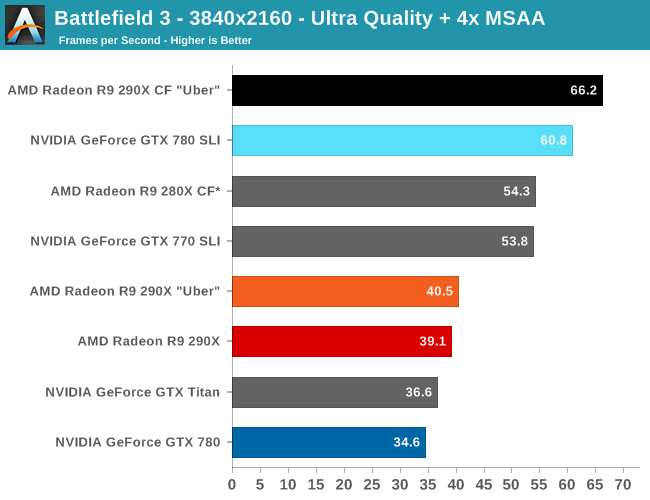

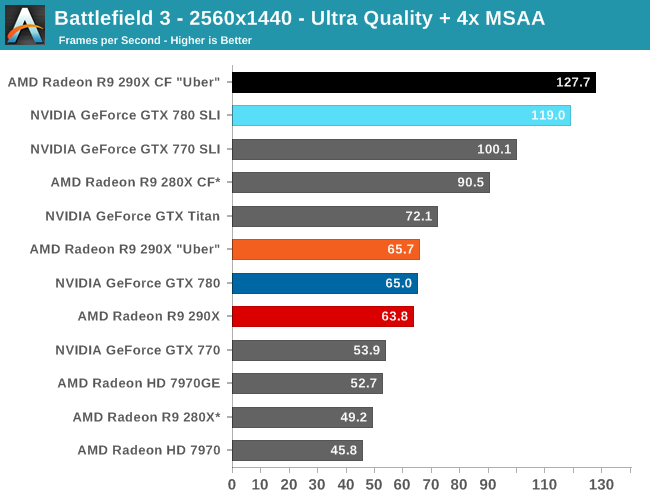
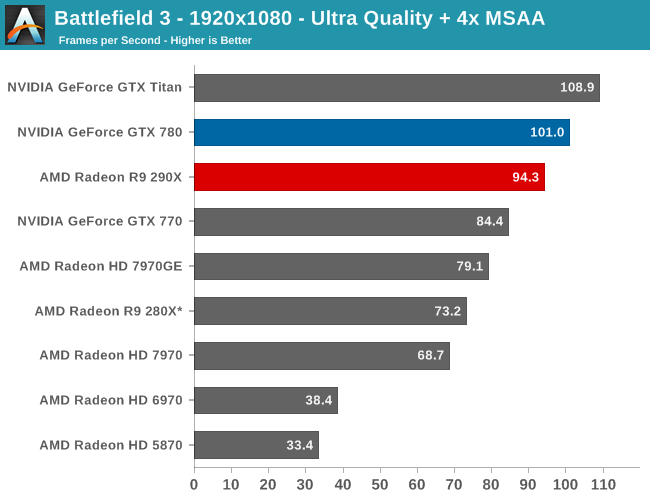
For our Battlefield 3 benchmark NVIDIA cards have consistently been the top performers over the years, and as a result this is one of the hardest fights for any AMD card. So how does the 290X fare? Very well, as it turns out. The slowest game for the 290X (relative to the GTX 780) has it losing to the GTX 780 by just 2%, effectively tying NVIDIA’s closest competitor. Not only is the 290X once again the first single-GPU AMD card that can break 60fps average on a game at 2560 – thereby ensuring good framerates even in heavy firefights – but it’s fully competitive with NVIDIA in doing so in what’s traditionally AMD’s worst game. At worst for AMD, they can’t claim to be competitive with GTX Titan in this one.
Moving on to 4K gaming, none of these single-GPU cards are going to cut it at Ultra quality; the averages are decent but the minimums will drop to 20fps and below. This means we either drop down to Medium quality, where 290X is now performance competitive with GTX Titan, or we double up on GPUs, which sees the 290X CF in uber mode take top honors. This game happens to be another good example of how the 290X is scaling into 4K better than the GTX 780 and other NVIDIA cards are, as not only does AMD’s relative positioning versus NVIDIA cards improve, but in heading to 4K AMD picks up a 13% lead over the GTX 780. The only weak spot here for AMD will be performance scaling for multiple GPUs, as while the 290X enjoys a 94% scaling factor at 2560, that drops to 60% at 4K, at a time where NVIDIA’s scaling factor is 76%. The 290X has enough of a performance lead for the 290X CF to hold out over the GTX 780 SLI, but the difference in scaling factors will make it cut close.
Meanwhile in an inter-AMD comparison, this is the first game in our benchmark suite where the 290X doesn’t beat the 280X by at least 30%. Falling just short at 29.5%, it’s a reminder that despite the similarities between 290X (Hawaii) and 280X (Tahiti), the performance differences between the two will not be consistent.

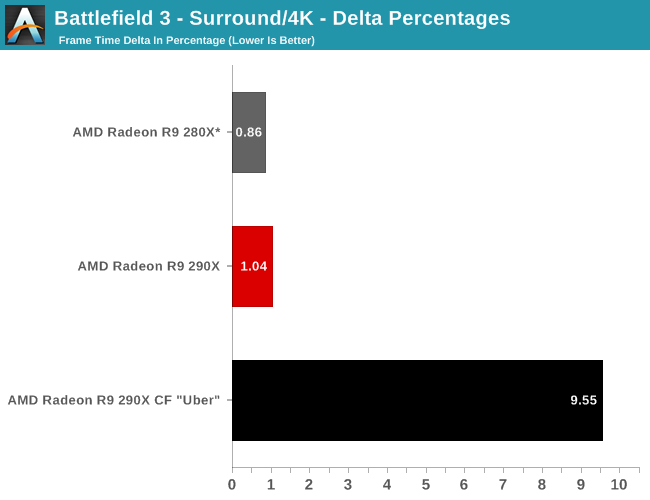
Looking at our delta percentages, this is another strong showing for the 290X CF, especially as compared to the 280X CF. AMD has once again halved their variance as compared to the 280X CF, bringing it down to sub-10% levels. This despite the theoretical advantage that the dedicated CFBI should give the 280X. However AMD can’t claim to have the lowest variance of any multi-GPU setup, as this is NVIDIA’s best game, with the GTX 780 SLI seeing a variance of only 6%. It’s a shame not all games can be like this (for either vendor) since there would be little reason not to go with a multi-GPU setup if this was the typical AFR experience as opposed to the best AFR experience.
Finally, looking at delta percentages under 4K shows that AMD’s variance has once again risen slightly compared to the variance at 2560x1440, but not significantly so. The 290X CF still holds under 10% here.


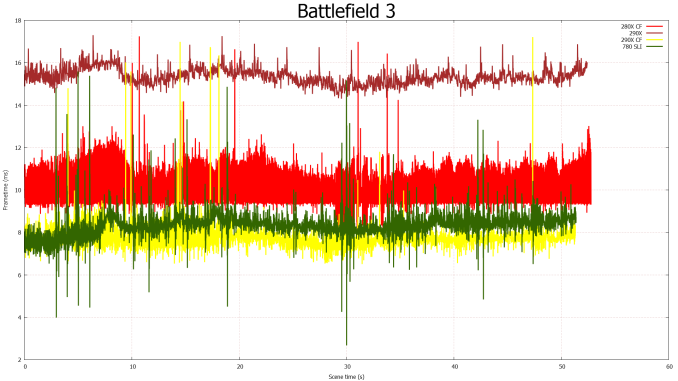
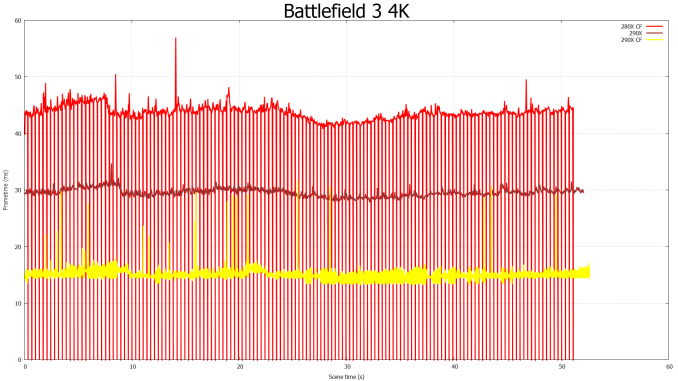








396 Comments
View All Comments
rituraj - Saturday, October 26, 2013 - link
So that "PROSUMER" cookie that nv tried to sell was just a grandma's cookie and it's proven now. I will buy the next maxwell flagship AND AT $600. (Lol.. I have to pay 20% more here in India)dazaj - Friday, October 25, 2013 - link
why is there no titan sli in all these benches but there is 290x cfRyan Smith - Friday, October 25, 2013 - link
Because we only have 1 Titan.just4U - Friday, October 25, 2013 - link
They likely didn't have two on hand..dazaj - Friday, October 25, 2013 - link
why is there no titan sli in any of these benchesdrinkperrier - Friday, October 25, 2013 - link
Just 1 question.Can i have the possibility to buy this videocard from AMD brand and not asus, sapphir and etc??
Ryan Smith - Friday, October 25, 2013 - link
Unfortunately no. AMD does not directly sell Radeon cards to consumers. They only directly sell Radeons to OEMs, while FirePros are directly sold to everyone.rituraj - Saturday, October 26, 2013 - link
The best thing I can get out of this release is that nVidia is not going to be able to charge $1000 for its next flagship or ultra-flagship. Because it's been proven that no matter what crazy performance it gives, it can be released at a 500-600 range by AMD and therefore by nVidia too. Even if they do, charge that much people will j7st wait for a few months for AMD to release an equally powerful card at 600 or 500. Good move AMD...SunLord - Saturday, October 26, 2013 - link
Saturday and I'm still not sure the reviews done or at least Anandtech has dropped making explaining and commenting on test resultspolaco - Saturday, October 26, 2013 - link
Origin PC will loose lots of possible sells by having dropped AMD. NVidia monopolistic friends pay the consequences...